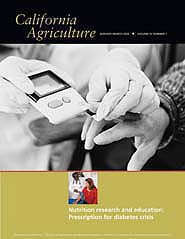All Issues

Nutrition research and education: Prescription for diabetes crisis
Cover:
The prevelance of diabetes in California has increased 67% since 1980. At south Stockton's Fifth-Street Medical Center, two-thirds of Dr. Kwabena Adubofour's clients are Latino and are significantly higher risk for the disease than non-Latino Whites. Adubofour takes the blood pressure of Esther Ferreira a 55-year old Stockton resident who was diagnosed with type 2 diabetes three years ago. She manages the disease with diet, exercise, and regular visits to the doctor. With the guidance of medical professionals such as Adubofour, UC Cooperative Extension advisors have developed diabetes prevention outreach programs to promote awareness and healthier lifestlyes among Latino's and other high risk populations. Color photo by Phil Schermeister .
January-March 2003
Volume 57, Number 1
Volume 57, Number 1





